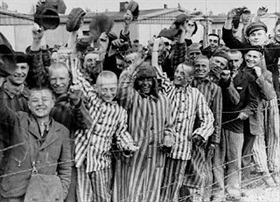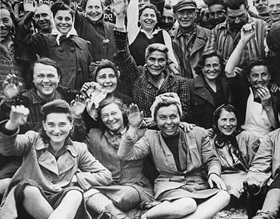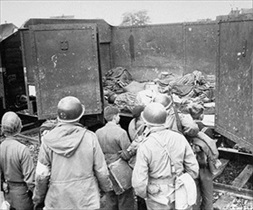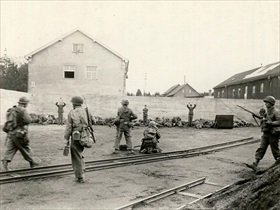WARSAW FALLS, MONSTEROUS CRIMES HINTED
Warsaw, Liberated Poland · January 17, 1945
On this date in 1945 Warsaw fell to Soviet and Polish Communist forces as the Nazis beat a hasty retreat from the ruins of Poland’s capital. In moving against the retreating Wehrmacht (German armed forces), the Soviets liberated 800 Jews in Częstochowa and 870 Jews in Łódź, Poland. Ten days later, on January 27, 1945, Soviet troops liberated the Auschwitz-Birkenau concentration/forced labor/death camp in Southwest Poland, where an estimated 1.1 million to 1.5 million people died, the most of any of the 15,000 camps and subcamps the Nazis had erected in occupied Europe. The troops found 648 corpses and 7,000 survivors. In the storehouses they uncovered 836,255 women’s coats, 6 tons of human hair, carpets, eyeglasses, artificial limbs, and more.
To the west, units of the U.S. Army on April 11 freed POWs in concentration camps at Buchenwald, where 56,000 had died, and on April 29 at Dachau, where 28,000 had perished between 1940 and 1945. American soldiers were so horrified by conditions at Dachau that a few GIs executed some of the SS personnel found there, including several pulled from the camp infirmary (charges against the men were dismissed); many guards were also killed by some of the 32,000 liberated prisoners. On April 15 British and Canadian units reached the Bergen-Belsen concentration camp in northern Germany, where they were met by horrific scenes—mass graves, unburied bodies, and nearly 40,000 “living skeletons,” emaciated and filthy men, women, and children who were starving to death or dying from typhus. On May 5, about 50 hours before Germany surrendered unconditionally, a U.S. armored unit reached the main Mauthausen camp in Upper (western) Austria, where 119,000 had died.
Three days later, on May 8, 1945, VE Day, Polish and Soviet units freed the camp at Stutthof (Sztutowo), Poland. A day later Soviet troops reached the Czechoslovak camp and ghetto of Theresienstadt (present-day Terezín in the Czech Republic), where they found 19,000 survivors. Even after liberation death took its toll: many victims succumbed to the effects of dehydration, starvation, disease, and exhaustion.
The monstrous crimes uncovered by camp liberators figured prominently in the cases brought against leading Nazis before the International Military Tribunal at Nuremberg, Germany in 1945–1946 (Trial of the Major War Criminals) and several of the subsequent Nuremberg trials (formally the Trials of War Criminals before the Nuremberg Military Tribunals) in 1946–1949.
Dachau Concentration Camp on Liberation Day, April 29, 1945
 |  |
Left: Liberated Dachau inmates cheer U.S. troops. Many broke into tears of joy, laughed, danced, and sang their national anthems—there were more than 40 nationalities at the Dachau concentration camp. The camp lay a scant dozen miles/19 km northwest of the Bavarian capital of Munich.
![]()
Right: Female prisoners at Dachau wave to their liberators. On April 26, 1945, as American forces approached, there were 67,665 registered prisoners in Dachau and its subcamps. Of these, 43,350 were categorized as political prisoners, while 22,100 were Jews, with the remainder falling into various other categories.
 |  |
Left: U.S. 7th Army soldiers force boys believed to be Hitler Youth to examine open boxcars containing 2,300 bodies of prisoners starved to death by the SS. Provisioned with little food or water the Dachau Death Train of nearly 40 boxcars had transported between 2,000 and 3,000 prisoners from Buchenwald concentration camp 19 days earlier to the Dachau concentration camp 250 miles/402 km to the south in the last days of the war. Upon their arrival only 1,300 inmates out of the 5,000 who had left Buchenwald were able to shuffle the short distance from the rail spur into the Dachau compound.
![]()
Right: Thrown off balance by the sight of starvation, cruelty, bestiality, and death all around them on the day of Dachau’s liberation, a small group of U.S. 7th Army soldiers executed at least 17 SS prisoners and wounded many more who fell to the ground in a coal yard next to the camp’s heating plant. Many of the liberated camp inmates beat SS men, informers, and Kapos (inmates who were given privileges in return for supervising prisoner work gangs) to bloody pulps or to death with fists, sticks, and shovels. Few of their American liberators intervened.
Dachau Concentration Camp Liberation, April 29, 1945
![]()

 History buffs, there is good news! The Daily Chronicles of World War II is now available as an ebook for $4.99 on Amazon.com. Containing a year’s worth of dated entries from this website, the ebook brings the story of this tumultuous era to life in a compelling, authoritative, and succinct manner. Featuring inventive navigation aids, the ebook enables readers to instantly move forward or backward by month and date to different dated entries. Simple and elegant! Click
History buffs, there is good news! The Daily Chronicles of World War II is now available as an ebook for $4.99 on Amazon.com. Containing a year’s worth of dated entries from this website, the ebook brings the story of this tumultuous era to life in a compelling, authoritative, and succinct manner. Featuring inventive navigation aids, the ebook enables readers to instantly move forward or backward by month and date to different dated entries. Simple and elegant! Click 











